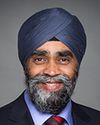Mr. Chair, as the previous Chair requested, I will be speaking for about eight to 10 minutes and then I will have a handful of questions for the minister afterward.
I am pleased to take part in this important debate surrounding the main estimates for the Department of National Defence. I want to thank the minister and the members of his team for being here for this grilling this evening.
While Canadians are blessed to live in a country that has not seen war within its borders since the 19th century, this does not make us immune from the repercussions of unrest elsewhere in the world, nor from emerging threats like global terrorism and cybercrime, nor natural disaster and severe weather effects, which are aggravated by climate change.
We have heard today how the Canadian Armed Forces and the Department of National Defence defend Canadians against these threats at home and abroad. When we have needed our women and men in uniform, they have answered the call time and time again, with the professionalism and expertise Canadians have come to expect of them. These are skills acquired through years of training and experience.
To accomplish their missions, our military members must be properly equipped. This is not a political issue; it is an operational imperative. As parliamentarians, we must ensure we provide them with the funding necessary to acquire the equipment they need and deserve.
There are challenges, however, the first of which is cost. We can all agree on the concept of a well-equipped military, but this must be carefully balanced against our responsibility to Canadian taxpayers to obtain value for money. We are not alone in this challenge. All around the world, our military allies and partners need to be strategic in their investments and limit costs and risk where they can.
Military equipment is built to specific standards. It is designed to be effective and durable, to remain in service for decades, to respond to and withstand emerging threats in a variety of environments. Much of this cost and risk is unavoidable, but it can be managed somewhat by planning for multi-purpose capabilities.
For instance, the new tactical armoured patrol vehicles, which the Canadian army first received in August 2016, was acquired to fulfill a variety of roles on the battlefield from troop protection, to reconnaissance and surveillance, armoured transport, and much more. This vehicle was deployed domestically for the first time earlier this month during the military response to the floods in Quebec. It proved to be of critical use as it was one of the only vehicles in all of the federal, provincial, and municipal fleets that could provide ground transportation in the flooded areas.
This flexible approach guides all aspects of the military's capability planning and it is particularly relevant for equipment.
This is just one example of sound procurement in action. The Department of National Defence manages more than 10,000 contracts per year, with a total value of nearly $6 billion. This includes everything from vehicles, weapons, and satellite systems to the purchase of items such as clothing and combat boots, rations, and ammunition.
National defence must also plan contracts for equipment maintenance and training as well as storage of equipment, all of which are required to maintain a capacity that is ready to quickly respond to operational needs.
There are challenges to the procurement process. That is undeniable. As we debate these issues and work to strengthen the procurement system, it is important to note that the vast majority of procurement projects are delivered on time and on budget.
The 2017-18 main estimates contain requests for funding for several critical projects for our armed forces, and I will list a few.
First are $189 million to continue the modernization of our Halifax-class frigates. This project is less than two years from completion and is both on time and under budget. It includes new radar capability, a new electronic warfare system, upgraded communications technologies, combat management systems, and more advanced missiles. These upgrades and several others will maintain our frigates as the backbone of the Royal Canadian Navy until the Canadian surface combatants are built.
The estimates also call for $156 million to upgrade the army's light armoured vehicles to provide them with improved mobility, protection, and ergonomics. Already, 409 of these vehicles have received upgrades, and this past February, we announced a multi-year, $404 million contract to upgrade yet another 141. This contract, which was awarded to General Dynamics, will extend the lifespan of the LAV to 2035 and sustain well-paying Canadian jobs.
To support the Royal Canadian Air Force in its missions, funding in these estimates will maintain and sustain many of our military aircraft, most notably the CF-18 fighter, the legacy Hercules, and the CP-140 Auroras, which continue to do outstanding work patrolling littoral approaches and provide valuable information to the coalition against Daesh in support of our operations in Iraq. This also includes the acquisition of 16 fixed-wing search and rescue aircraft to replace the legacy Buffalo and Hercules fleets, which was a major procurement success following many years of delay.
Moving beyond the current year and into the future, progress is being made on several major procurement projects.
First, we will undertake an open and transparent competition to replace the CF-18 fighter fleet, as Canada requires an advanced fighter capability to enforce our sovereignty, provide continental security, and contribute to international peace and stability. We are also exploring an interim acquisition of fighters in order to manage our commitments to both NORAD and NATO.
I can also report, being from the east coast, that real progress is being made with the shipbuilding strategy. Work has begun on the second Arctic offshore patrol vessel, which will be known as HMCS Margaret Brooke, and the project remains on schedule. A contract will be issued later this year for the design of the Canadian surface combatant, which will become the mainstay of the Royal Canadian Navy's future fleet.
These are significant developments, and we have already taken steps to ensure that funding is available to support these large-scale capital projects for defence by reallocating $8.48 billion of funding from the period of 2015-16 to 2035-36 to future years. This is done to ensure that funding is available when it is needed. Indeed the total funding available to National Defence for large-scale projects is $83 billion over the next 30 years.
As we have heard many times tonight, when the new defence policy is unveiled on June 7, I am confident it will contain further measures to improve our procurement process, measures that will be fully and adequately funded in the years to come.
Our women and men in uniform are a source of national pride for Canadians. I know that everyone in this room supports the members of the Canadian Armed Forces because we know they will answer the call, just as they always have. To ensure they can accomplish their assigned missions, we must ensure stable and predictable funding for the Department of National Defence. That is our role as parliamentarians. We must also strive to continually improve our procurement systems, ensuring that military acquisitions provide value to Canadians by being fiscally responsible, while investing in the Canadian industrial base.
I have a handful of questions for the Parliamentary Secretary to the Minister of National Defence.
In the minister's speech, he mentioned the challenges related to the procurement process and our responsibility to Canadian taxpayers. All members in the House can agree that we want to see the Canadian Armed Forces acquire new equipment, vehicles, ships, planes, as quickly as possible.
Could the parliamentary secretary please explain to the House what the Department of National Defence and the Canadian Armed Forces are doing to improve the procurement process and to address the challenges I have outlined?




